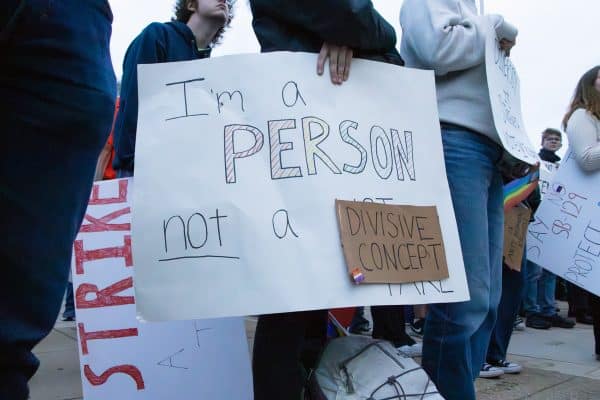Review | This crime flick is more American than we want to believe
‘Scarface’ has become an American classic – probably because it gets at the heart of our political struggles.
More stories from Avery Brooks
What is the American dream? There are several answers to this question, varying from person to person, but the essential idea of the American dream seems to be that America, at its best, is a place where anyone can start with nothing, and eventually make something of themselves. Whether or not this is true, its persistence as an idea indicates something hopeful about the American psyche. It suggests that we as a people genuinely believe in our own ability to live on our own terms. There have been many on-screen attempts to wrestle with this concept, but for my money no American film better depicts this idea in action better than Brian De Palma’s 1983 masterpiece, “Scarface.”
“Scarface” is an example of a film, like “Pulp Fiction” or “Fight Club,” that has taken on a second life as a poster on dorm room walls. Like the gangster films of Martin Scorsese, it depicts a sordid life of crime which is equally enticing and repelling to those who watch it (it would make an excellent double feature with Scorsese’s 2013 opus, “The Wolf of Wall Street”). The story, as much as there is one, follows Tony Montana (problematically played by Al Pacino), a Cuban immigrant in the early 1980s, who finds himself living in Miami as a minimum-wage worker fighting to make something of himself. There are very few “legitimate” ways to do so for a poor immigrant with a criminal background, so Montana and his friend Manny Ribera (Steven Bauer) find themselves working for coke dealer kingpin Frank Lopez (Robert Loggia). Tony is pleased to have found himself in such a lucrative market, but his ambition and gutsy bravado far outweigh those of his associates, and he quickly finds himself skyrocketing to the top of the underworld.
It’s a common rags to riches tale, probably familiar to anyone who has seen any gangster film made in the last three decades. Brian De Palma, famously a “love him or hate him” director, allows the story to unfold over a span of more than three hours. De Palma’s stylistic trademarks, such as longshots, split screen or dangerous female characters, are held in check more than in many of his other works of the period, but what the film lacks in obvious auteurist shorthand, it makes up for with sheer style. Perhaps no film has captured the simultaneously vacuous and thrilling nature of the drug world as this one has. Every room looks like a cavernous dance club, every house is a gaudy mansion, and there is rarely any room for silence in this world, unless someone is about to be murdered. The appeal of the movie speaks for itself: It is a thrillingly constructed piece of filmmaking, and its admittedly daunting three-hour runtime moves by so quickly that one might wonder where all the time went.
One of the contradictions of the movie is that for a film where every single scene looks so glamorous, the life of crime presented seems so utterly soul-destroying and void of purpose. People are shot at by people no better or worse than they are. Characters use cocaine not because it makes them feel good but because it numbs them to the horror of their own lives. Interestingly, for as great a performance as Al Pacino gives in the lead, one rarely gets a sense of who Tony Montana is. He isn’t greedy for a reason; he’s greedy because there are too many things in the world that aren’t already his. He voraciously consumes those around him, chewing them up and spitting them out.
For a film so dominated by macho aesthetics, the film’s two major female characters present an interesting dichotomy. Tony pursues his boss Frank’s wife Elvira (Michelle Pfeiffer) with a passion, promising her that he loves her and that he can treat her well and give her a family. Once they do marry though, Tony feels he has conquered her, and he has no more need to show love. Pfeiffer gives a blisteringly sad monologue toward the end of the film, and it is one of the moments in the film where a character’s humanity shines through the clearest. Even more interesting is Tony’s relationship with his sister Gina (Mary Elizabeth Mastrantonio), whom he at first seems protective over. But as the film goes on his darker impulse toward her becomes clear. His desire to possess everything around him can’t be satisfied with Gina, whom he has corrupted with drugs and money, and the tragic conclusion of their story is deeply disturbing.
“Scarface” is a remake of a 1932 gangster film of the same name, and anyone who knows Brian De Palma knows that he is obsessed with filmmaking techniques of the past (many of his critics accuse him of stealing from Alfred Hitchcock, a criticism perhaps not without some merit), but what is surprising about the film is just how modern it feels. Even though it is soaked in the 1980s, it seems just as prescient today. Tony Montana begins the film talking about how much he hates communism (the reason he left Cuba) and claims he will “kill a communist for fun.” This dialogue is reflected later, as Tony sits in a golden bathtub in his mansion, complaining about capitalism, and how it won’t let someone like him get ahead. He is a “bad guy,” and though America essentially needs people like him, he can never escape his own evil. It is a miracle that a film about vacuous people and lives wasted is as exciting, and rich, as this one is.










